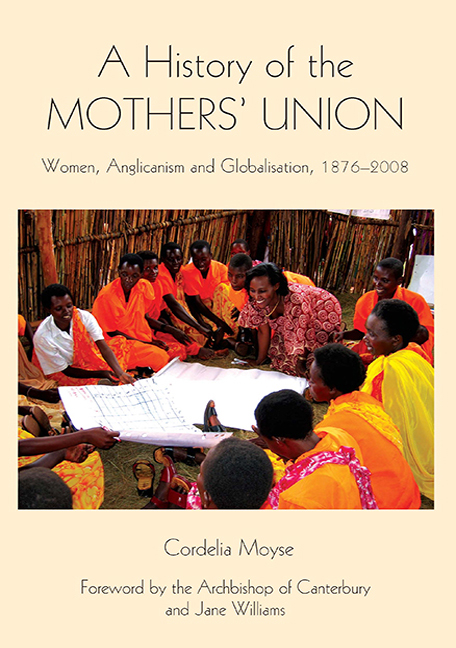Book contents
- Frontmatter
- Contents
- Dedication
- List of Illustrations
- Foreword by the Archbishop of Canterbury and Jane Williams
- Acknowledgements
- Abbreviations
- Introduction
- Part I 1876–1909
- Part II 1910–1944
- Part III 1945–1974
- Part IV 1975–2008
- Conclusion
- Appendix 1 Text of early membership cards
- Appendix 2 Development of the Mothers' Union prayer
- Appendix 3 Midday prayers (original)
- Appendix 4 Development of the objects
- Appendix 5 Biographical notes on central and worldwide presidents
- Bibliography
- Index
- Miscellaneous Endmatter
- Frontmatter
- Contents
- Dedication
- List of Illustrations
- Foreword by the Archbishop of Canterbury and Jane Williams
- Acknowledgements
- Abbreviations
- Introduction
- Part I 1876–1909
- Part II 1910–1944
- Part III 1945–1974
- Part IV 1975–2008
- Conclusion
- Appendix 1 Text of early membership cards
- Appendix 2 Development of the Mothers' Union prayer
- Appendix 3 Midday prayers (original)
- Appendix 4 Development of the objects
- Appendix 5 Biographical notes on central and worldwide presidents
- Bibliography
- Index
- Miscellaneous Endmatter
Summary
History books tend to be written for one of two reasons. The author is seeking either to correct what was wrong in a previous teller's tale, or to tell a new tale, which will cast new light on historical developments and open up new fields of enquiry. This book on the Mothers’ Union falls largely into the second category. The audience for which it is written is primarily that of historians of women, the Church and the British Empire.
It is an unlikely story that begins in 1876 in a vicarage drawing-room in rural England with a nervous rector's wife hoping to start a new women's group in her local parish. It ends, as far as this account is concerned, 130 years later in 2008 with a still-growing organisation of 3.6 million women in 78 countries. It is a story that, scandalously, has been ignored by the very historians whose interest and expertise one would have thought could only lead them to study the largest female religious organisation of the nineteenth and twentieth centuries in Britain and her territories. An organisation whose very growth, especially in its early years, could ‘hardly be paralleled outside the pages of the Acts of the Apostles’ and which in its heyday in the British Isles on the eve of the second world war, boasted over 500,000 members. Even at the beginning of the twenty-first century when most mass voluntary membership organisations have disappeared as the underpinning of UK civil society, the MU has over 100,000 members. Furthermore it is more active than ever in national political life as well as in community service in Britain. Internationally it is present in non-governmental organisation fora such as the UN's Economic and Social Council's Commission on the Status of Women. Its name still resonates in popular culture even if it is associated with an image of 1950s Britain, and its purpose confused with the secular Women's Institute, from which it could not be more distinct as a faith-based organisation with a membership largely drawn from Africa and Asia. The Mothers’ Union, through its banners hanging in virtually every parish church and cathedral in the country, is literally woven into the fabric of national and church life.
- Type
- Chapter
- Information
- A History of the Mothers' UnionWomen, Anglicanism and Globalisation, 1876–2008, pp. 1 - 14Publisher: Boydell & BrewerPrint publication year: 2009



